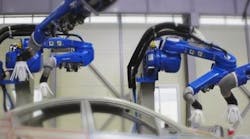Manufacturers today need to be confident in their capabilities to produce better quality products in the safest environment possible, while managing to save on costs. This assurance can be especially difficult to come by when the product assembly process includes manual painting, coating or other chemical application. However, fine-tuning the spraying process via industrial robotic automation offers key benefits that can help manufacturers thrive.
1. Create a Safer Working Environment
Challenge: As with any manual task, concern for worker safety is paramount, and the common way for manually spraying paint or adhesive onto a part during product assembly can present risk factors and challenges. The use of spray glue and coating materials, especially in a confined space with poor air circulation, poses the potential for flammable situations or toxicity exposure. Likewise, the repeated back-and-forth motion across each work piece can cause common manual spray-gun use injuries, such as chronic arm or wrist strain.
Solution: Paint robots are Factory Mutual (FM) approved for use in Class I, Div. 1 hazardous environments, and they are used for handling, spraying or dispensing applications in hazardous or flammable environments, where other industrial robots are not allowed by code. Automating with paint robots can isolate hazards and remove workers from dangerous situations, freeing them to be robot path programmers.
2. Provide Consistent Finishes for Improved Quality
Challenge: Spray inconsistency is a common occurrence during manual operations and creates poor product quality. If workers experience pain or ergonomic challenges during product assembly, most likely there will be noticeable movement compensation, causing part feed hindrance and coating application irregularity. Coating uniformity is extremely important to product quality, especially if the surface or panel is to be covered with high-gloss finish. A surface with a non-uniform quantity of coating has the tendency to show an orange peel effect, resulting in unwanted texturing.
Solution: FM approved industrial robots are capable of performing dispensing applications 24 hours a day, 365 days a year. Programmed to work efficiently, they require minimal maintenance and have few overspray issues, providing consistent part finishes and improved product quality.
3. Save on Materials and Costs
Challenge: When workers demonstrate signs of fatigue or injury, most likely, time consuming movement compensation is taking place. This reduces throughput and creates significant coating wastage, increasing material costs.
Solution: Automating a finishing process can increase output while reducing costs, providing benefits for years to come. Plus, the accuracy that painting and dispensing robots can provide has the potential to reduce material consumption by up to 30 percent.
4. Fill the Skills Gap
Challenge: Companies, especially in rural areas, struggle to hire enough skilled workers to maintain the production required to meet market demands. Moreover, many production jobs are boring and/or dangerous positions to fill, causing high employee turnover rates. This, in turn, creates worker inconsistency and poor product quality.
Solution: The use of automation is helping many companies, especially small- to mid-size manufacturers, fill the labor gap.
5. Focus on Flexible Solutions
Challenge: Because manual operations require complex production planning and demand extensive change-over times, manufacturers struggle to keep pace with consumer demands.
Solution: Robots help manufacturers efficiently adjust to market demands. Versatile designs offer floor, wall or ceiling mounted locations for layout flexibility, and automation – in general – can simplify production, providing the flexibility many businesses need to succeed.
6. Gain a Strong Competitive Advantage
Challenge: When manufacturers are faced with a spray application that could potentially benefit from automation, choosing the best robot or automation solution can be overwhelming. From cost to capabilities, there’s much to consider, including the decision to hire a skilled programmer or train a current worker to operate the robot. Either way, manufacturers that fail to understand the cost-savings associated with long-term automation risk falling behind their competition.
Solution: Robots efficiently dispense paint, adhesive and other materials onto complex shapes, reducing material costs and improving safety by reducing the exposure of human workers to potentially hazardous fumes. Yaskawa Motoman’s new high-speed MPX1150 and MPX2600 robots are ideal for a variety of spray applications, consistently creating smooth finishes.
Optimized for painting smaller components, the compact MPX1150 has a 5 kg payload capacity and is well-suited for mounting a variety of spray guns and small bells.
The MPX2600 is ideal for automotive components and other industrial applications, and boasts a 15 kg wrist payload, allowing for mounting a variety of spray guns and large bells.
With Yaskawa Motoman’s commitment to complete customer satisfaction and wide range of robotic painting products and technology, manufacturers can be confident in their capabilities to produce quality products, with the freedom to change and expand in the future.










